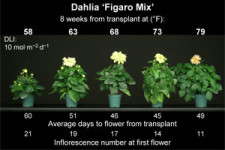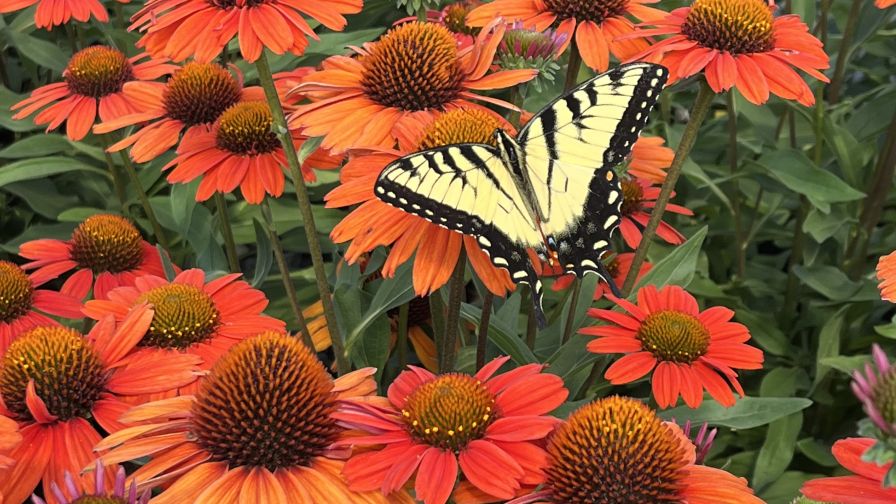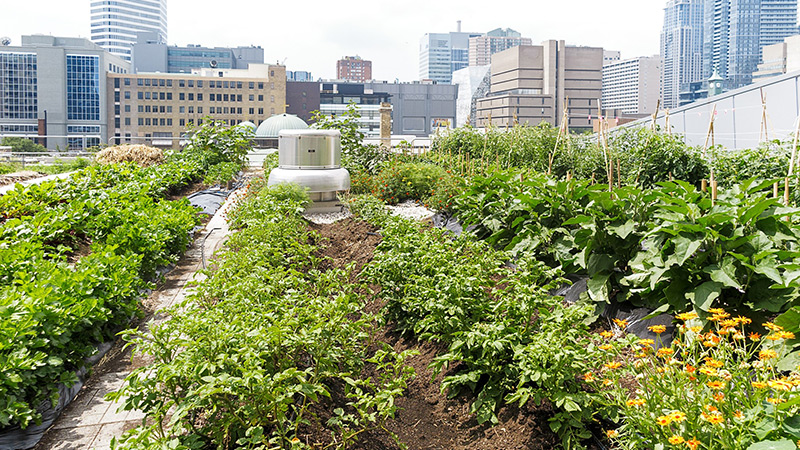Energy-Efficient Annuals: Dahlia & Osteospermum

Producing spring bedding plants in an energy-efficient manner requires information on how crops respond to average daily temperature and daily light integral (DLI) so bedding plants can be more precisely scheduled. At Michigan State University (MSU), we have performed experiments with numerous seed-propagated annuals to quantify how these environmental factors influence flowering time and plant quality.
In the ninth article of this series, we present crop timing data on dahlia (Dahlia × hybrida) and osteospermum (Osteospermum ecklonis) and then use that information to estimate greenhouse heating costs at different locations, growing temperatures and finish dates.
Materials & Methods
Seeds of dahlia ‘Figaro Mix’ and osteospermum ‘Passion Mix’ were sown in 288-cell plug trays by C. Raker & Sons and grown in controlled environmental growth chambers at MSU at a constant 68°F (20 °C). Inside the chambers, the photoperiod was 16 hours and the DLI was 9 to 11 mol∙m¯²âˆ™d¯¹. This DLI is typical of that received in greenhouses in early spring in the Northern United States.
When plugs were ready for transplant (26 to 30 days after seed sow), they were thinned to one seedling per plug and transplanted into 4-inch (10-cm) pots and grown in greenhouses with constant temperature set points of 58, 63, 68, 73 and 79°F (14, 17, 20, 23 and 26°C). At each temperature, plants were grown under a 16-hour photoperiod with two different DLIs provided by sunlight, a combination of shade curtains and different supplemental lighting intensities from high-pressure sodium lamps.
Dahlia is typically a facultative short-day plant. Although plants flower under long days, flowering is accelerated under short days. In contrast, osteospermum is typically a facultative long-day plant, meaning plants flower faster under long days.
Our experiments were performed twice to obtain average DLIs that ranged from 4 to 19 mol∙m¯²âˆ™d¯¹. To give perspective, a DLI of 4 mol∙m¯²âˆ™d¯¹ is representative of light conditions received by a northern greenhouse on a cloudy day in the winter; a DLI of 19 mol∙m¯²âˆ™d¯¹ is typical for inside a greenhouse on a mid- to late spring day. We recorded the flowering date when each plant had an inflorescence with one whorl of petals fully reflexed. On that date, plant height and number of inflorescences (flower number) were recorded.
Crop timing data were used to develop mathematical models to predict flowering time and plant quality under different temperature and DLI conditions. The Virtual Grower 2.5 software (available free at VirtualGrower.net) was used to estimate the cost to heat a 21,504-square-foot greenhouse (about half an acre) to produce each crop for different finish dates and at different locations in the U.S.
Results
In both dahlia and osteospermum, time to flower decreased as average daily temperature increased from 58 to 73°F. For example, in dahlia grown under a DLI of 10 mol∙m¯²âˆ™d¯¹, time to flower from a 288-cell plug decreased from 60 days at 58°F to 45 days at 73°F (Figure 1). Our crop model predicted the shortest flowering time in this dahlia variety occurs at an average daily temperature of 72°F, and flowering is delayed at warmer temperatures. The crop timing data for dahlia is for plants grown under long days, and flowering may have been accelerated if short days had been provided. Regardless of day length, we anticipate similar temperature trends on crop development rates.
In osteospermum, plants grown under a DLI of 10 mol∙m¯²âˆ™d¯¹ and at 73°F flowered two weeks earlier than plants grown under the same DLI, but at 58°F (Figure 2). To illustrate the effect of temperature on dahlia and osteospermum crop times, we identified dates 288-cell plugs grown under long days would need to be transplanted for two market dates when finished under long days and a DLI of 10 mol∙m¯²âˆ™d¯¹ (Table 1).
As the DLI increased, time to flower in both crops decreased. For example, in plants grown at 63°F, increasing the DLI from 5 to 15 mol∙m¯²âˆ™d¯¹ accelerated flowering of dahlia by 15 days and of osteospermum by three weeks. The estimated saturation DLI for the shortest time to flower was 16.4 mol∙m¯²âˆ™d¯¹ for dahlia and 18.8 mol∙m¯²âˆ™d¯¹ for osteospermum. In other words, increasing the DLI above these values did not shorten crop times.
The influence of DLI on flowering time also illustrates the benefit of using supplemental lighting is greatest when the natural DLI is lowest (during the winter and early spring). For example, our models predict osteospermum grown at 68°F would flower 16 days earlier if the DLI was increased from 5 to 10 mol∙m¯²âˆ™d¯¹, and only three days earlier if the DLI was increased from 10 to 15 mol∙m¯²âˆ™d¯¹.
In both crops, flower number increased as average daily temperature decreased and as DLI increased. For example, under a DLI of 10 mol∙m¯²âˆ™d¯¹, as average daily temperature decreased from 79 to 58°F, flower number increased twofold in dahlia and sevenfold in osteospermum (Figure 1 and 2). In both crops, plants grown at 79°F and under 4 mol∙m¯²âˆ™d¯¹ developed only four to six inflorescences before flowering, and plant quality was low.
Plant height at flower decreased as DLI increased and as average daily temperature decreased. Dahlia and osteospermum grown cool and under high light (58°F and DLI of 18 mol∙m¯²âˆ™d¯¹) were 9 inches (23 centimeters) shorter than plants grown warm and under low light (73°F and DLI of 4 mol∙m¯²âˆ™d¯¹).
Heating Costs
We used this crop timing information and Virtual Grower to predict the amount of energy consumed to produce a flowering crop of dahlia and osteospermum for April 1 or May 15. Our models project the least amount of heating is required on a per-crop basis when grown at 58 or 63°F in all seven locations tested.
For example, osteospermum grown in Charlotte, N.C., at 58°F instead of 73°F would save growers 26 percent on heat if grown for a finish date of April 1. Growers would save 56 percent on heat if grown for a finish date of May 15. Similarly, a greenhouse located in Grand Rapids, Mich., would consume 14 to 28 percent less heat per square foot per crop if grown at 63°F compared with 73°F.
For dahlia and osteospermum, it was more energy efficient to transplant earlier in the spring and grow crops at a cool temperature than to transplant later and finish warm. Furthermore, plant quality was considerably higher when crops were grown at these lower temperatures, especially in osteospermum. For many of the other crops we have discussed in this article series, such as seed geranium (see Greenhouse Grower, September 2009), energy consumption was lowest when crops were grown more quickly by using a warmer temperature (at least 68°F). Therefore, energy-efficient production of a variety of bedding plants requires some crops to be grown cool and others to be grown in separate greenhouse sections at warmer temperatures.
The cost of energy for heating is just one of the many production expenses for greenhouse crops. Other factors, such as the number of crop turns and labor availability, should also be considered when choosing the most economical growing temperature for each floriculture crop producer. The impact of temperature and DLI on plant quality, and response variability among cultivars, should also be considered.
0
1
5
Energy-Efficient Annuals: Dahlia & Osteospermum










